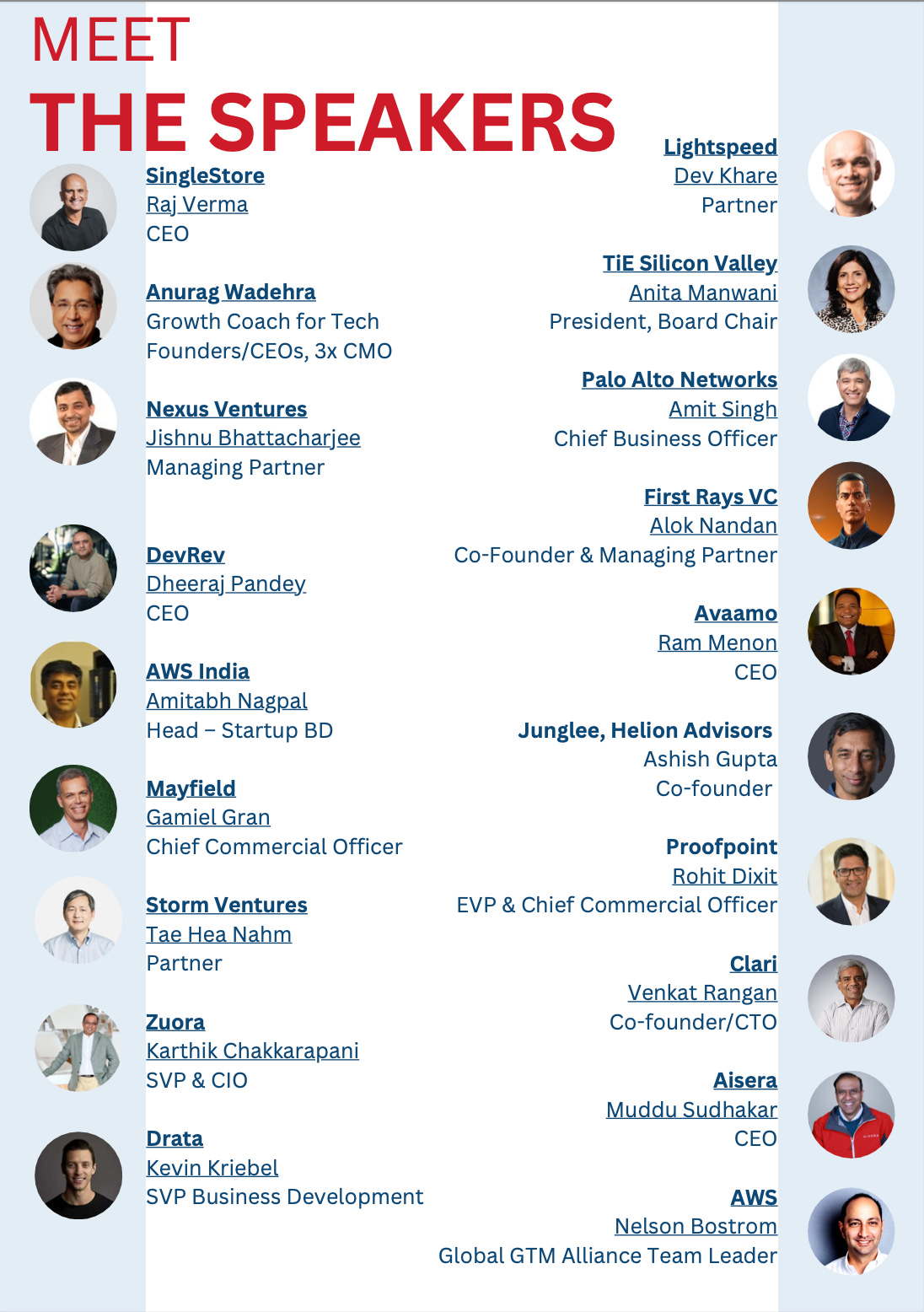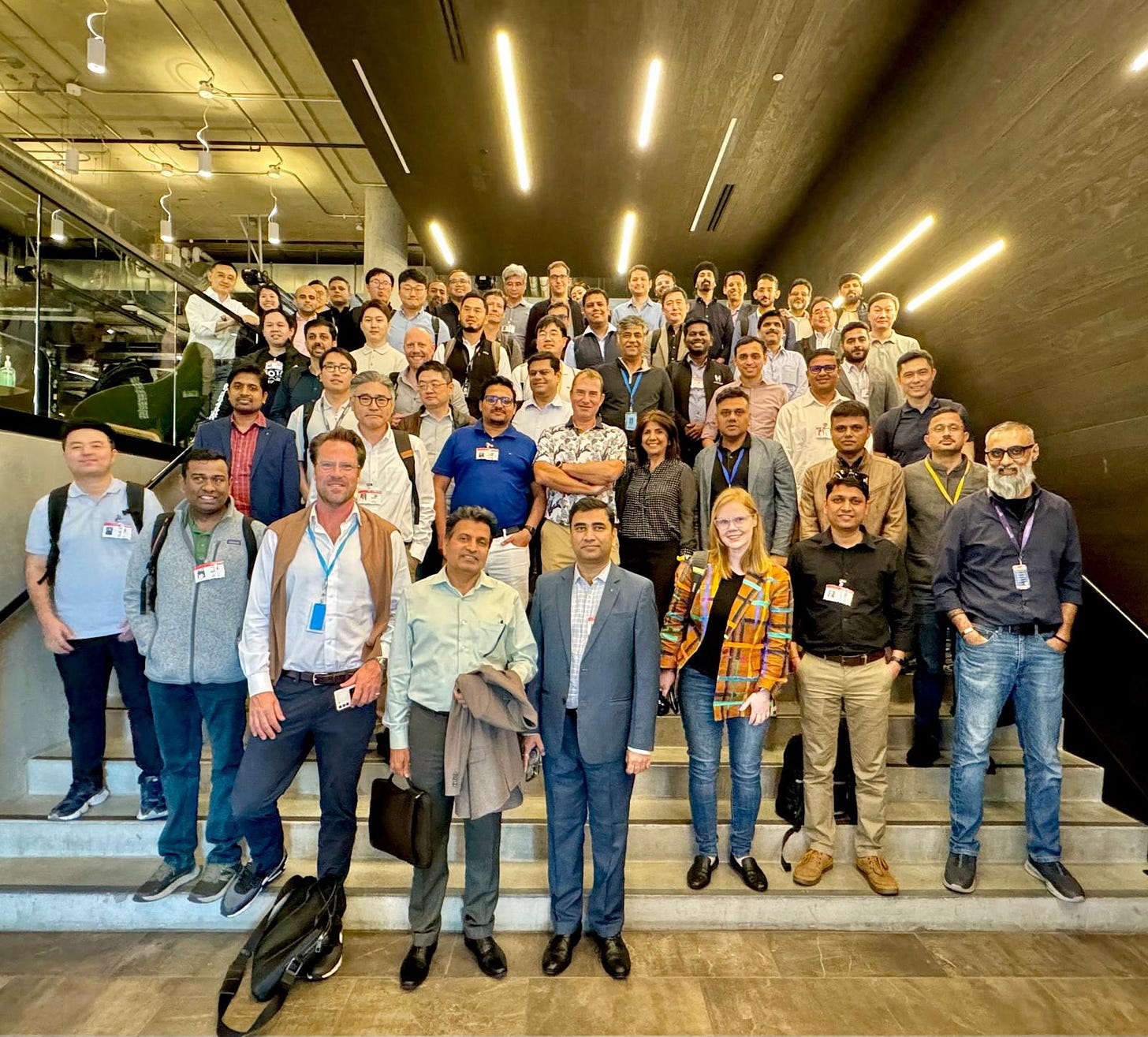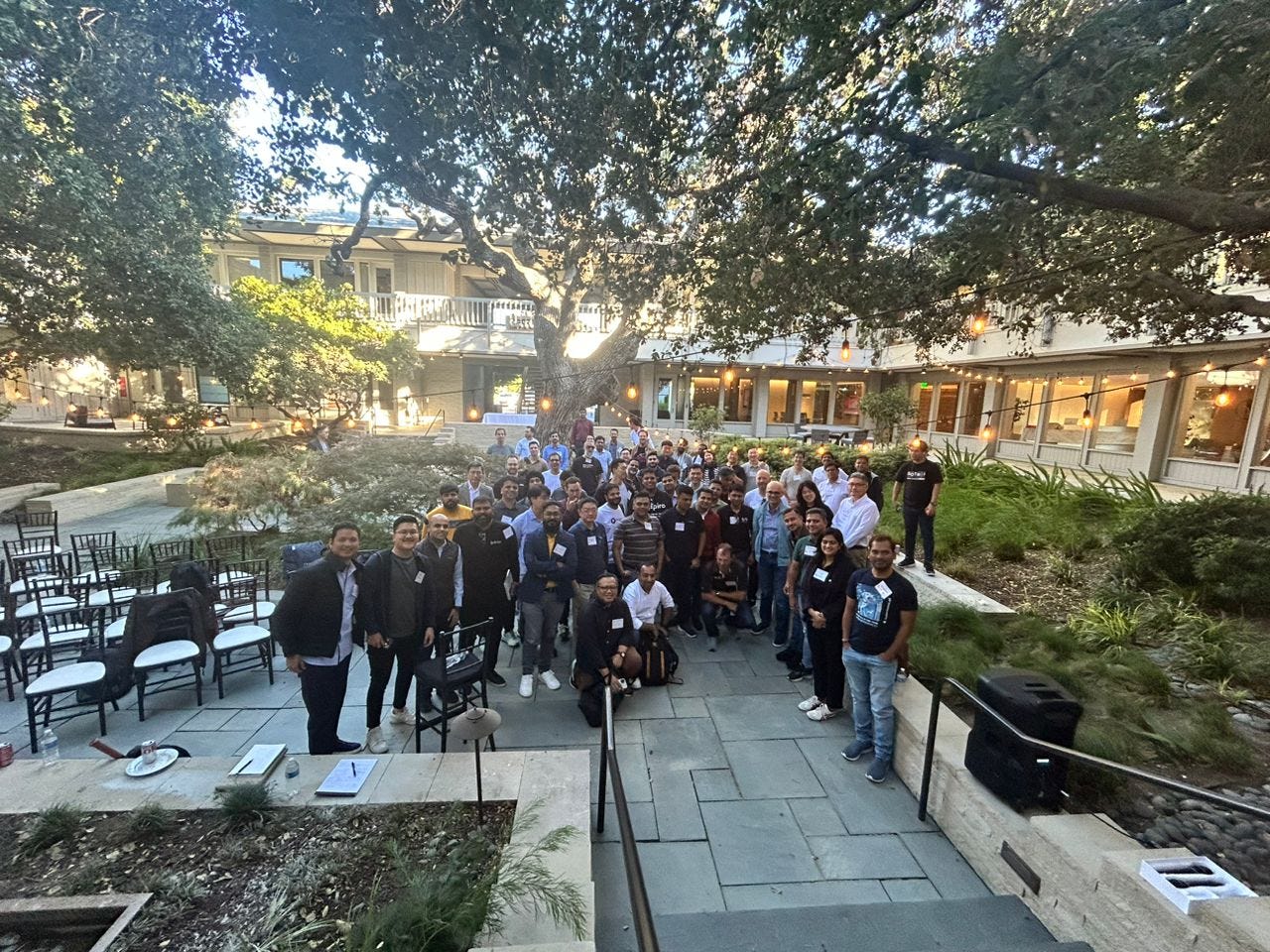Proven Strategies To Conquer The US Market For Startups
Lessons from a week of immersion with the best international startup founders and operators
Together they have generated tens of billions of economic value.
Across venture capital, fast growing startups, and publicly listed companies.
Amazingly, they came together in a concentrated week of learning for a group of 70+ founders from India, Korea, Australia, New Zealand, Singapore, Indonesia and other international markets.
Hosted by TiE Global and Amazon Web Services, this power packed lineup held court in Palo Alto. Just as impressive were the stories and lessons shared by other founders in the room.
I picked out some key highlights for me.
Here’re the three main buckets of learning for early stage cross-border startups looking to enter the US market:
GTM & Market Entry Benchmarks
Product Trends
People & Team
1. GTM & Market entry benchmarks
Top 2 sessions for me:
Dheeraj Pandey, CEO of DevRev
Dev Khare, Partner at Lightspeed Ventures
Much of the wisdom here treads familiar ground. It was just greater reinforcement when it comes from other seasoned operators and thinkers who have seen it themselves and through others, and know what they’re talking about.
The need to be in market in the US
Dev noted that international founders are moving to the US earlier and earlier. While previously the advice was to build to Series A or B, grow in their local market first before coming out here, the data shows that in those cases there’s a high tendency to overfit the product and GTM to the local market.
Today, the most successful founders are moving to the US from seed stage or even before. The overwhelming consensus view is that unless the founder and product managers are in the US market, your chances of winning are very much reduced.
Speaking to other founders in the group, some of whom have up to 50% of their revenue already from the US, this seems to be more true the higher your ACVs are (upwards of $1,000 seems to be the cut-off) and the more you rely on a human sales process.
Product-led startups have a chance of gaining customers, but will see their growth limited if founders, product managers or at the very least very senior executives aren’t in-market.
“Founder Mode” and Founder-led sales
Not another post about founder mode.
I’m glad that across the board, most of the advice around this was specific to founder-led sales.
Everyone recommends that founders sell first, until about 20-25 customers that are reference-able: ie each customer fits a specific ICP and can identify other customers as within the same niche.
The speakers unanimously advised against delegating the sales function too early to a VP, or worse, to resellers.
For those who need convincing, here’s a summary of why:
Deep Product Knowledge and Passion: Founders know their product inside and out, allowing them to effectively communicate its value and address customer pain points with authenticity and passion that others may lack.
Direct Customer Feedback Loop: Founders can directly hear customer feedback, enabling them to quickly iterate and refine the product to better fit market needs, accelerating product-market fit.
Building Trust and Credibility: Customers are more likely to trust and engage with the founder, seeing them as highly invested in solving their problem, which helps establish strong, early customer relationships.
I personally observed Dheeraj in action two years ago at a booth in SaaStr, where they’d just started DevRev and he was personally giving demos at the booth. To random swag-hags like me.
Last week he shared a handy needs-hierarchy for buyers when dealing with startups that’s worth remembering:
Will they go out of business?
Will they leak my data?
Will they make me look good?
In that order.
Don’t underestimate the time and money it’ll take
The benchmark here seems to be to treat the investment in the US market as exactly that.
Allocate a $500K-$1M “seed fund” and give it 2-3 years to see traction.
There seems to be precious little that can be done offshore for less money: content generation perhaps, but Dev warned against overstaffing with lower-cost offshore resources.
Beyond the lack of market familiarity and communication nuance, there’s also the non-trivial problem of the management overheads of a (for example) 50-person team in India compared to a 5-person team in the US.
2. Product trends
Not surprisingly, Generative AI is still the flavor of the month (quarter? year?) with many speakers sharing their thoughts on where it fits in within product suites, business models, etc.
Notable sessions for me:
Raj Verma, CEO, Single Store
Ashish Gupta, Co-founder Helion Advisors, Board Member of multiple startups
Don’t chase shiny objects!
Raj reiterated advice from Jeff Bezos to avoid chasing the next big tech trend, and instead think hard about what things in your industry won’t change in the next 3-5 years.
Then build your tenets of product strategy around them.
In the data center business, customers would never want slower speeds, or less uptime.
What are some of the things in your business that wouldn’t change? And how can you build your business and product strategy around those?
Play to your advantage as a startup
But if these are things that don’t change in your industry, surely your giant competitors would have already optimized the hell out of solving them?
Not so.
I was reminded about the big-company bloat that inevitably happens when companies get bigger.
Code bases get stale.
Decisions are made more by committee.
Bosses spend more time guarding turf than building product.
etc.
The advantage that incumbents in your industry have is distribution. They will outsell you, have locked-in relationships, a better brand.
The advantage that you have as a startup is innovation. You can apply a new way of solving a problem that is 10X better.
Seek out early adopters and keep growing from there.
And watch out for selling to other slow moving BigCos that say they want the innovation, AND ALSO the legacy sh*t.
It’s like a buyer who says “oh yes I’d like the automobile please, it looks better than a faster horse. But I also need it to pull a carriage.”
“Outcome as a service”
Most interesting conversation I had about GenAI was around the idea of “Outcome as a Service”.
Software has become more and more commoditized recently, much as SaaS founders hate to admit it.
GenAI tools have made it even more so.
It has never been easier to clone apps, user flows, write code.
It has also never been more important to deeply understand user Jobs To Be Done (JTBD) and ensure that our product actually delivers the outcome that it was ‘hired’ to do.
However that product is delivered.
Stick with me.
If you need a standard legal document drafted and proof-read, you could ‘hire’ ChatGPT to do it. Or any of the plethora of LegalTech AI startups out there.
But more likely than not, it’ll deliver an output that still requires you to edit and amend it. Possibly even additional legal counsel to give it a once through.
What if instead of selling a LegalTech AI SaaS, you sold the outcome of a fully functional legal document?
Sure, there’ll be a human in the loop, say a practicing lawyer.
Sure, margins may be low initially (say ~30%). The lawyer may be able to review only 10 documents a day.
Over time however, with greater and greater optimization, you could get that human in the loop to be a lot more efficient with AI.
To possibly reviewing 100 documents a day. At a 70-80% GM.
The process then becomes the product, and the outcome is delivered in a way that the user has the JTBD completely fulfilled.
Now this is starting to look a lot more like a tech company, financially.
The thesis is that founders from emerging markets (eg Asia) would have an advantage in such business models.
Because of a naturally lower cost base, and the familiarity with customer demands in their home market that already ask for humans in the loop beyond technology.
This is more likely for “high velocity” services (things that can be done by a human in 1min to ~1 hour) than “high value” services (like consulting, delivering workshops etc).
Food for thought for Asian (and all really) founders.
3. People & Team
In the early stages of a startup, which many speakers defined as under 50 employees, there are certain things about running the team that are worth remembering.
Missionaries over mercenaries
Without disrespect to Big Tech or BigCo employees, seasoned founders shared that these hires almost never work out when joining an early stage venture.
Mindset mismatch: They struggle with the fast-paced, ambiguous nature of startups, which contrasts with the structured and resource-rich environments they’re used to.
Execution over strategy: Startups require hands-on execution, while senior hires from big companies are often accustomed to focusing more on strategy and managing teams.
Resource limitations: Expectations for support, budget, and resources in a startup are often unmet, leading to frustration when compared to the abundant resources in larger corporations.
There are of course exceptions, but personally I’ve found this to be true too.
How do you find these exceptions?
Generally, they would have found it hard to fit in their BigCo roles from before.
Always trying new things, coloring out of their lines and stepping on others’ toes.
Doing lots of projects on the side.
And deeply understanding the value of equity / stock options.
Early stage startup employees willingly invest their salary in the startup and demonstrate belief in the mission through participation in ESOPs as part of compensation.
There’s a lot written about missionaries and mercenaries (all the way back to John Doerr at the turn of the century), but this seemed to be a good litmus test.
When you find them, make the effort to engage their families, because joining a startup is a family decision.
Whether it’s a partner or spouse, for great talent make sure they are on board too and try your best to reach out to them personally.
At scale, you want to be at around US$300K revenue per employee, but this isn’t going to happen at the beginning.
So hire those first few team members carefully!
Final thoughts
I was left reflecting on this quote a lot from Raj Verma at the end of the week, and I’ll leave you with it too.
You can be right or wrong as a CEO, but never confused.
Raj Verma, CEO Single Store







